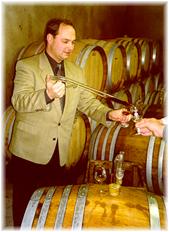| Introduction
| How Wine is made I
| How Wine is made II
| How Wine is made III |
| Climate and Quality
| Serving and Testing
| Wine and Food
|
II. HOW WINE IS MADE III
 A less modern, but still wide widely used way to ferment wine is to place
it in small oak barrels. "Barrel fermentation"
is usually done at a lower temperature in temperature controlled rooms
and takes longer, perhaps around 6 weeks. The longer fermentation and use
of wood contributes to the flavor (and usually expense) of the wine.
A less modern, but still wide widely used way to ferment wine is to place
it in small oak barrels. "Barrel fermentation"
is usually done at a lower temperature in temperature controlled rooms
and takes longer, perhaps around 6 weeks. The longer fermentation and use
of wood contributes to the flavor (and usually expense) of the wine.
The skins and pulp which remain in a red wine vat will rise to and float on top of the juice. This causes problems (if it dries out, it's a perfect breeding ground for injurious bacteria), so the winemaker will push this "cap" back down into the juice, usually at least twice a day. In large vats, this is accomplished by pumping juice from the bottom of the vat over the top of the cap. Some winemakers use a screen to keep the cap submerged at all times.
Eventually the yeast is no longer changing sugar to alcohol (though different strains of yeast, which can survive in higher and higher levels of alcohol, can take over and contribute their own flavor to the wine--as well as converting a bit more sugar to alcohol).
After all this is completed, what you have left is the wine, "dead" yeast cells, known as "lees" and various other substances.
In years of poor weather in many winemaking countries, including the leading regions of France, when the grapes cannot fully ripen, beet or cane sugar is added to the grape juice before fermentation in order to bring the alcohol level up. The process is called chaptalization and it is important to point out that all of the sugar is used up during fermentation (the yeast converts it to CO2 and alcohol). Deutscher Tafelwein, Deutscher Landwein and QbA wines may be chaptalized; Prädikat wines may not - it is illegal to do so.
Aging of wine
Most German wines of the QbA and Kabinett grades are ready to drink when you buy them.
Buy these in a recent vintage to enjoy their youthful freshness.At most,
buy them when they are not more than four or five years old.

Spätlese, too, may be consumed young, but it is likely to be enjoyable even five to ten years after bottling.
The higher grades - the Auslese types - are usually longer-lived, generally reaching their peak when they are from
seven to ten years old. With good storage, they will continue at their best for many years thereafter.
Wines from the Rheingau (a famous wine region) often take a few more years to reach their full perfection,
while other Rhine wines - from region Rheinhessen; Pfalz, Nahe - tend to mature a bit faster.
The Riesling wines of Mosel-
|
Wine develops for the first six months or even longer in the cask. But even after bottling it continues to mature. |
Storing wine
- Do not store wine near goods that emit strong odors, because the wine "breathes"
through its cork and has a tendency to absorb odors from the air.
- When such ideal conditions do not exist, the most important consideration is to find a place where the temperature
does not fluctuate wildly.
- A quiet, cool spot such as a closet, hallway, unused fireplace, or space under the stairs will do.
- Warm places such as the kitchen or bright, light places such as near a window are not recommended.
- Wine should always be stored lying horizontally, so that the cork remains moist and elastic.
- Only wines with metal caps can be stored standing up.
An ideal spot for wine is one that is cool, dimly lit, moderately humid,
relatively quiet and where the temperature is a constant 50° to 55° F (10° to 12° C).